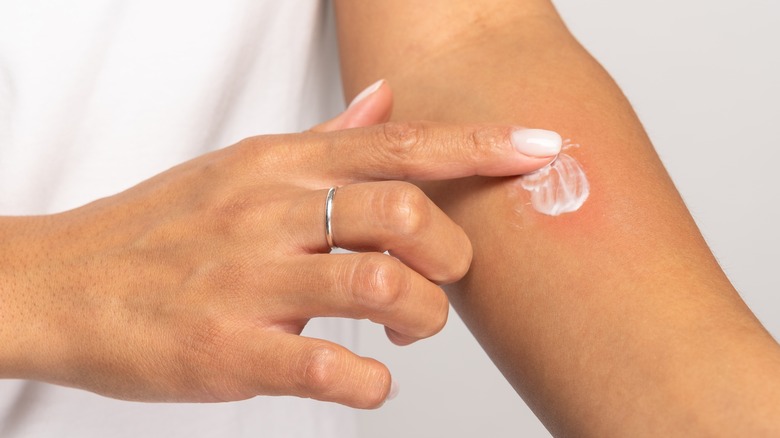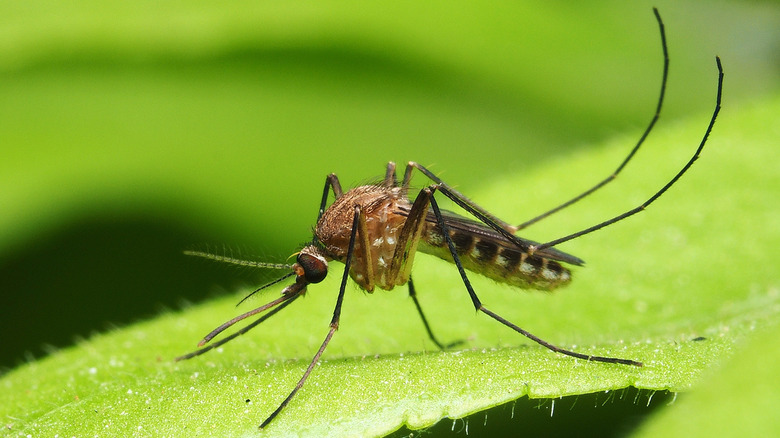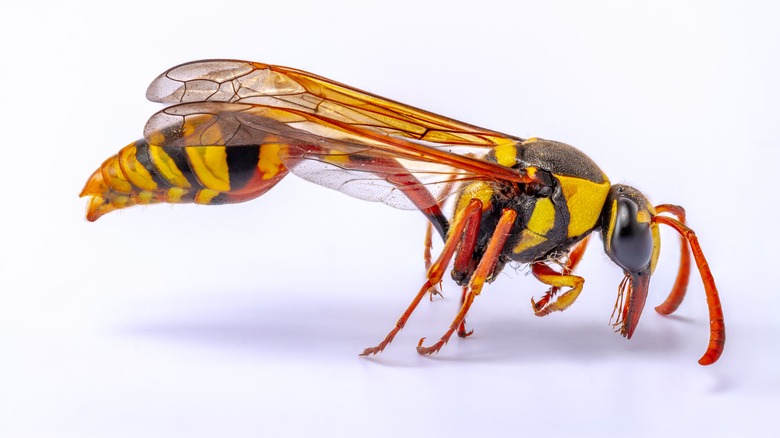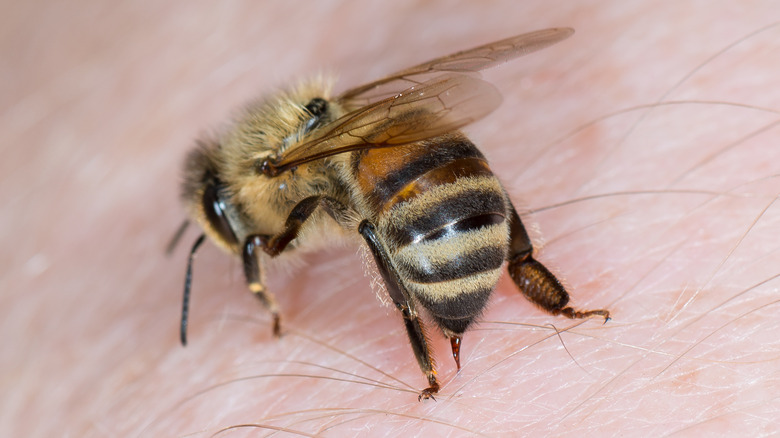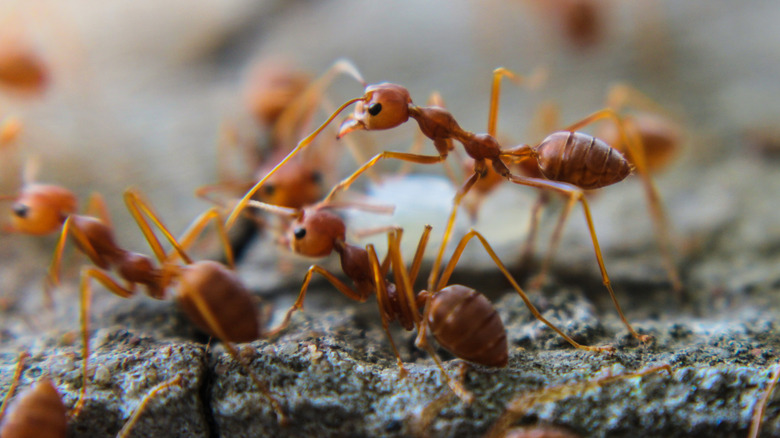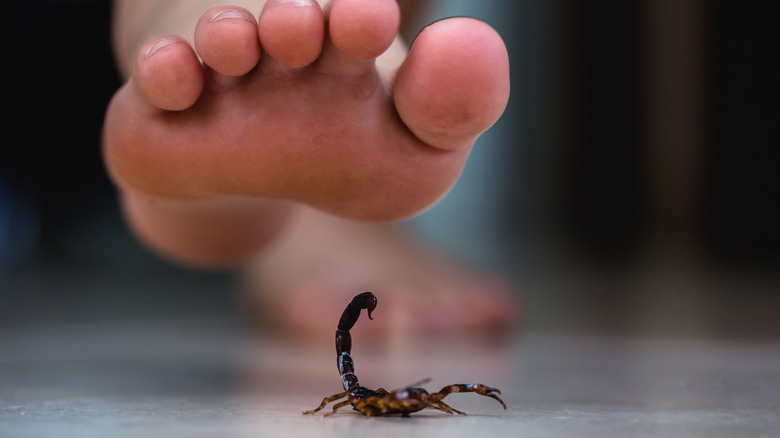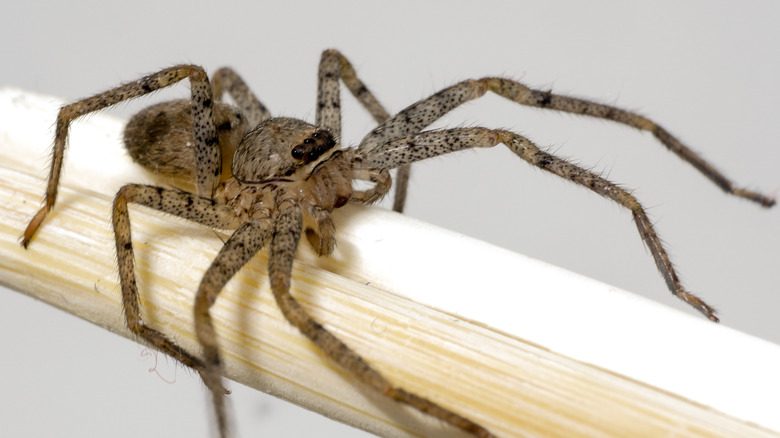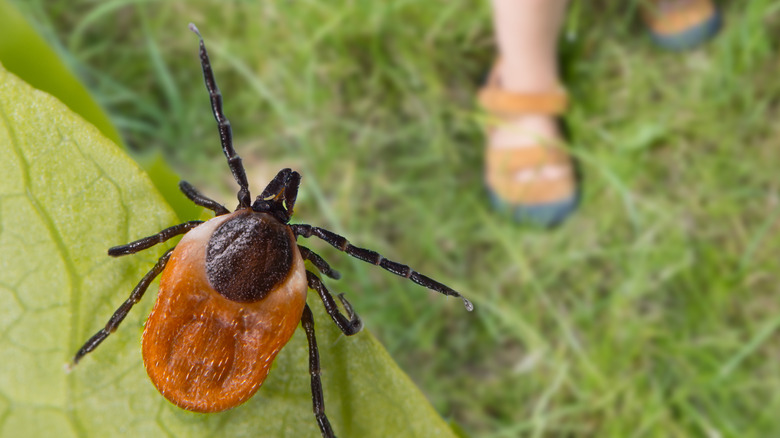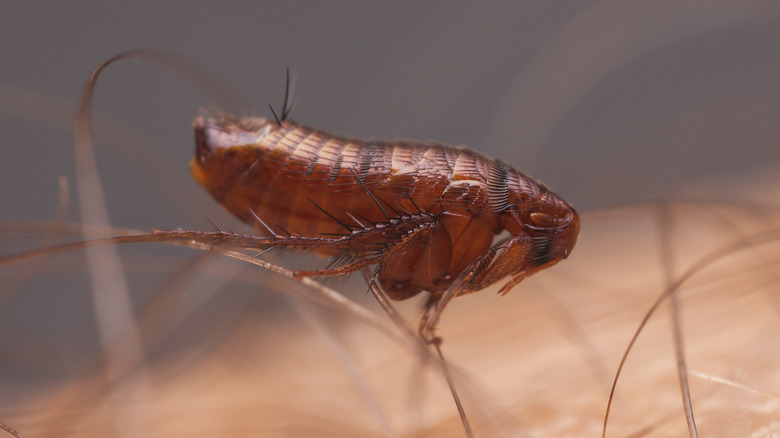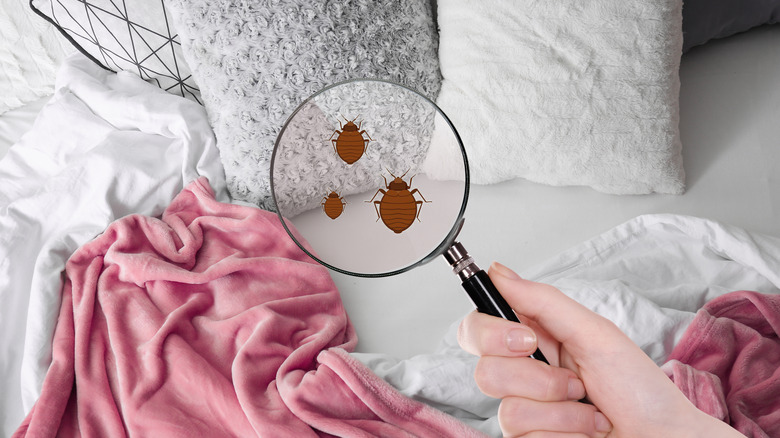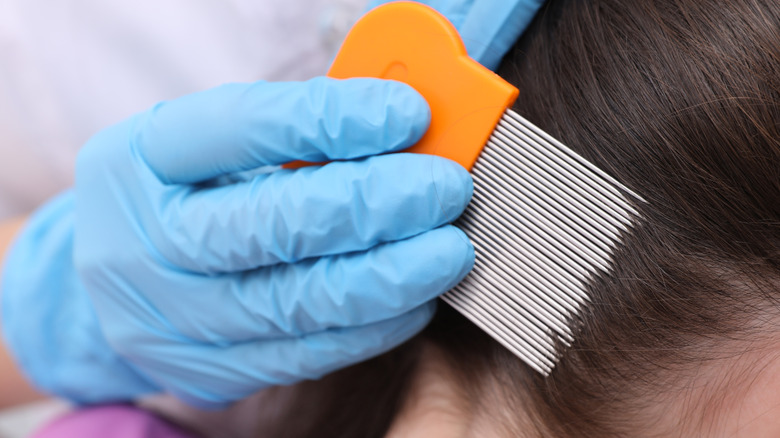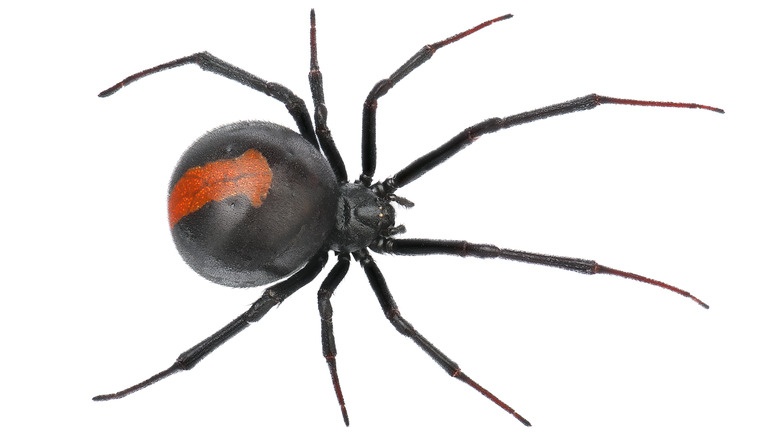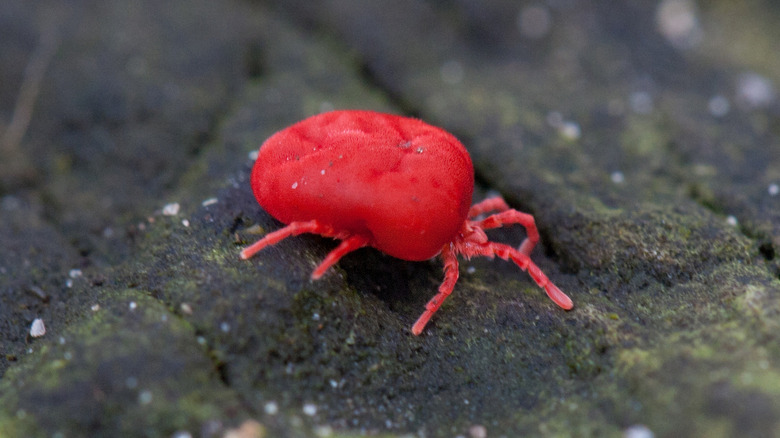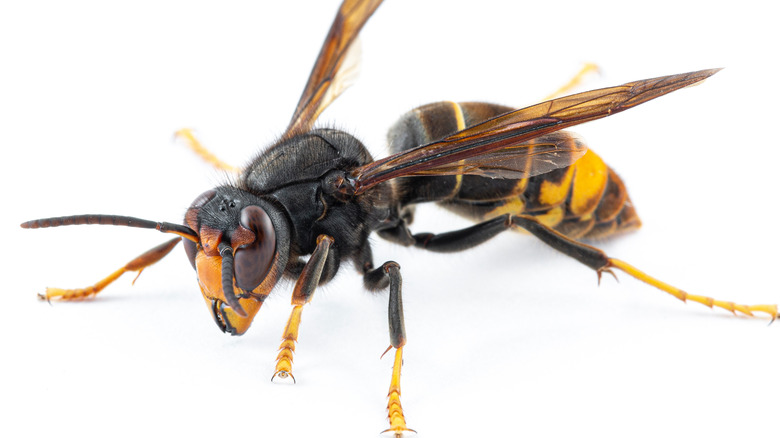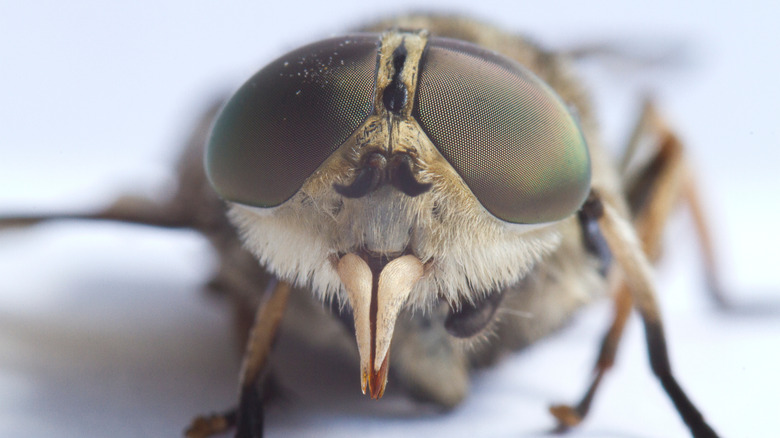Bug Bites And Stings Explained: Types, Symptoms, And Treatments
While bug bites can certainly be uncomfortable, they are rather common — and in many cases, very treatable. Getting bitten by a bug can set off a chain reaction of anxiety-ridden thoughts and worst-case-scenario-type thinking, but having an identification guide and knowing how to treat yourself can help lessen some of that anxiety.
According to Everyday Health, reactions to bug bites can range from mild to requiring immediate medical attention, and the symptoms of the bite will alert you to how severe it really is. Experts at the site explain that the majority of bug bites are "transmitted directly from the insect," and typically occur outdoors (with the exception of certain bugs that hop from person to person or infest indoor areas). In many cases, the side effects of bug bites can be treated immediately and eliminated. Meanwhile, other bites can transmit diseases that can leave long-lasting effects, such as West Nile Virus (borne from mosquitoes) and Lyme Disease (which comes from ticks). Furthermore, allergies can exacerbate symptoms that may otherwise be mild and lead to reactions that may require immediate medical intervention.
Continue reading to learn about 13 different types of bug bites, their symptoms, and how best to treat them.
Mosquito bites
Tiny, annoying, bloodthirsty, and persistent are just a few words you could use to describe the ever-present mosquito. However obnoxious, existing on the same planet as this tiny vampiric creature is something that simply must be accepted.
As the Mayo Clinic explains, a mosquito bite is what's left after the mosquito has used their "mouthparts to puncture your skin and feed on your blood." Yikes. The mouthpart of the mosquito pierces the skin, injecting saliva into it and producing the characteristic raised red and itchy mark. The mark appears just a few minutes after the bite; however, it typically disappears within a couple of days. In some cases, the bite of the mosquito can leave a large, raised, and swollen area, which can also be known as "skeeter syndrome."
For children or those with compromised immune systems, reactions may be more severe, and may include a low-grade fever, hives, or even swollen lymph nodes. That said, most mosquito bites will heal on their own, though you can also apply a cooling lotion such as calamine lotion or hydrocortisone cream directly on the bite. For more extreme cases, you can take an oral antihistamine to help reduce itching and swelling. A cold compress may also provide relief.
Yellow jacket stings
Getting stung by a yellow jacket is no walk in the park. According to Healthline, a yellow jacket is a type of wasp that is thin and has yellow and black markings that make it similar in appearance to honey bees. In contrast to honey bees, yellow jackets live in nests instead of hives, and do not make honey.
Furthermore, yellow jackets have the ability to sting multiple times. When they sting, they pierce their stinger into your skin and inject a venom that causes immediate pain. Symptoms of being stung by a yellow jacket include swelling, tenderness, redness, and pain at the site of the sting, as well as warmth around the sting area and fatigue. More severe symptoms can occur as a result of an allergic reaction, and may include coughing, trouble breathing, and even vomiting or diarrhea.
If you suspect you're having an allergic reaction, it's imperative to seek medical attention immediately. To treat a yellow jacket sting, experts recommend using a cold compress at the site of injection, taking an antihistamine, or using a homemade paste of baking soda and water and applying it directly to the site.
Honey bee sting
While honey bees do a lot of good for us in terms of pollinating our crops and providing honey and beeswax, they also have a tough side. For the most part, bee stings will only require at-home treatment (per the Mayo Clinic). In some cases, however, bee stings can trigger a much more serious reaction that requires medical intervention.
When bees sting, they inject a "barbed stinger" into the skin, along with venom that affects the immune system. Most cases of bee stings are mild, with symptoms including an instantaneous sharp pain at the site of the sting followed by a welt and swelling around the area. However, some people do experience moderate symptoms, which can include "extreme redness" and swelling that increases for the next couple days. For those who have an allergic response to bee stings, symptoms can be as severe as difficulty breathing, "a weak, rapid pulse," and even a loss of consciousness.
For mild stings, start by removing the stinger with your fingernails, then wash the area with soap and water and apply a cold compress. For moderate reactions, you can use an over-the-counter pain reliever, elevate the affected area, or take an oral antihistamine.
Fire ant sting
You might think of ants as just small, unassuming, and hardworking members of the animal kingdom, but like honey bees, these bugs also have a "spicy" side.
According to Medical News Today, while most people that have had an unfortunate encounter with this insect may have assumed they got bit, the ants actually don't bite — they sting. Ants that are called "fire ants" include two species that are not native to the U.S., but were imported from South America. Fire ants sting in an attempt to defend their mounds, injecting venom into the skin that produces an "intense pinching and burning pain" right after the sting takes place. This leaves a small, pus-filled blister. After the initial sting gives way, you will experience either an itching or burning sensation that gradually increases over time, eventually dissipating over the next few days. If you have an allergic reaction to fire ants, you may experience trouble breathing, dizziness, and confusion among other symptoms.
To treat a fire ant sting, you can use home remedies such as applying a cold compress or hydrocortisone cream, taking an oatmeal bath, or taking antihistamines.
Scorpion sting
The stuff of old Western Movies, encountering a scorpion can be a frightening experience that leaves you feeling uneasy for some time to come. Getting stung by one? Even more traumatizing.
As Healthline explains, while it is possible to die from a scorpion sting, only 30 of the 1,500 species of scorpions have venom that is strong enough to provide a fatal dose. The bark scorpion is the only venomous species of scorpion in the United States. Most scorpion bites do not require medical treatment and can be taken care of at home. After a scorpion stings you with its tail, you are likely to experience a very intense, sharp pain, followed by numbness, tingling, and swelling around the site of the sting. If the venom is more "widespread," some of those symptoms may include muscle twitching, drooling, breathing difficulties, vomiting, irregular heartbeat, sweating, and more.
Most scorpion stings won't require treatment. However, if symptoms are more intense, antivenom may need to be administered. Furthermore, if you are experiencing symptoms such as muscle spasms, a sedative may also need to be used.
Brown recluse spider bite
Another tiny creature you don't want to find anywhere near your home, brown recluse spiders are found in central and southern United States (per Healthline). They also give one of the more serious bites on this list.
Brown recluse spiders are known for the characteristic violin-shaped patch on the back of their heads. Because they are not aggressive spiders, they will only bite if they are pressed against the skin. Typically, you won't feel the spider bite you, but symptoms will develop after a couple of hours. These include pain, burning, itching, and redness around the site of the bite. A blister may also occur. Secondary symptoms include a high temperature, nausea, chills, a rash, and sweating. After 12 to 36 hours have passed, the spot on your skin where you were bitten may turn dark blue or purple with a white halo around it, accompanied by redness.
Getting bitten by a brown recluse spider is an emergency, so you should visit the hospital immediately if you think you've been bitten. While en route, experts at the site suggest washing the site of the bite with soap and water, elevating the area, and applying a cold compress.
Tick bite
If you've ever been camping or hiking, you've most likely been warned about the dangers of tick bites. While most tick bites are actually harmless, they can provoke allergic reactions, as well as transmit diseases that have the potential to be deadly (via Healthline).
Ticks are found outdoors in grassy areas and leaf piles. They are blood-sucking insects, and are therefore attracted to people and animals, typically biting in warm and moist body parts or areas. Ticks will attach themselves to the skin, bite, and begin to suck blood, remaining attached until they are full. In many cases, the bite is "harmless" and won't cause complications. However, if you are allergic to tick bites, you may experience pain, burning, and difficulty breathing. If the tick that bit you carried a disease, symptoms may include a red spot near the spot where you were bitten, nausea, headaches, swollen lymph nodes, and more.
To remove the tick, Healthline suggests grabbing a pair of tweezers, pinching the tick pulling upwards, and ensuring that all of the insect has been carefully removed from the skin.
Flea bite
If you've ever had a pet, you may have either encountered fleas or at least taken measures to prevent their appearance. According to the Cleveland Clinic, these small, flightless insects have sharp mouthparts and strong legs that allow them to pierce your skin, feed on your blood, and hold on for dear life. While the bites themselves don't usually cause any long-term damage, fleas may carry diseases that can be deadly.
When a flea bites you, it injects its saliva into the skin, provoking an immunological response that causes itching and swelling at the site of the bite. The bites produce small, reddish bumps that may occasionally appear in a straight line or in clusters. Fleas also tend to bite on the legs, more specifically the feet, calves, and ankles. Symptoms of bites include irritated, itchy skin, as well as possible allergic reactions such as shortness of breath, nausea, and dizziness.
Bites rarely require serious treatment. More often than not, over-the-counter anti-itch creams or antihistamines will be enough. You can also apply aloe vera, chamomile tea, honey, and oatmeal to manage itching.
Bed bug bite
Bed bugs have a nasty reputation for being persistent and tough to get rid of. Another parasitic insect, bed bugs feed on blood and have a particular taste for humans, hence their attraction to beds.
Medical News Today explains that while these bugs are labeled as a "public health concern," they do not carry diseases that can be transmitted to humans. They use what is called a proboscis to pierce the skin and draw blood, and will bite anywhere on the body where they can. The bite itself may not be felt, but the after-effect, a red dot at the site of the bite, will produce itching and irritation. The bite may also appear as a red dot with a clear or black center, with blisters and hives surrounding the bite site. Bites may also produce burning and pain.
Allergic reactions are rare, but they may result in labored breathing, nausea, fever, and more. Furthermore, the way the bites open the skin may make it prone to secondary infection. To treat bed bug bites, the site recommends washing the affected area with soap and water, then taking over-the-counter hydrocortisone, anti-itch creams, and antihistamines.
Lice bites
The mere mention of lice might take you straight back to your childhood days, when the threat of having to shave your head had you frantically checking your strands at the end of the day.
Per Medical News Today, lice can actually be divided into two categories: chewing lice and sucking lice. The former survives off of "skin and debris." The latter sucks on blood, and is the only type that lives on humans. Head lice are approximately 2 to 3 millimeters in length, are grey in color, and live on the scalp. They suck on blood from the scalp and lay eggs, also known as "nits," on the hair shaft. The shells of the eggs can stay stuck in the hair for up to six months after the lice have hatched, and are likely to be found behind the person's ears or at the nape of their neck. Symptoms of head lice include itching of the scalp, neck, and ears, which is a sign of an allergic reaction to lice (via the Mayo Clinic). The most notable sign will be the eggshells around the ears and the hairline.
Lice can be transmitted through sharing hats and scarves, headphones, pillows, towels, etc. If you have head lice, go to your doctor. They will prescribe you over-the-counter medication to kill the lice and their eggs.
Black widow spider bites
Black widow spiders are widely known for their strongly venomous bites, as well as the hourglass mark on the underside of their abdomen. According to WebMD, there are actually two kinds of black widow spiders in the United States: the Southern Black Widow, which carries the characteristic hourglass mark, and the Northern Black Widow, which has a row of red dots that run along the middle of the abdomen. Both of these spiders are nocturnal, can be found in dark spaces, and only bite when provoked.
Symptoms of being bitten by a black widow spider include stiff, painful, muscles — which usually occurs within eight hours of the bite — nausea, trouble breathing, extreme cramping in the abdomen, muscle tremors, swollen eyelids, rashes and itching, and more. This bite can be deadly to children, so if you think your child has been bitten by a black widow, visit the emergency room immediately. If you've been bitten, wash the area with soap and water, apply a cold compress, take a pain reliever, and elevate the affected area. After you visit the doctor, they will decide what further measures to take (if any are necessary).
Chigger bites
Although barely detectable by the human eye, when you get bit by chiggers, the after-effects are anything but subtle.
According to Healthline, chiggers are members of the arachnid family, and are tiny, red, and live in grass, weeds, wooded areas, and berry patches. They prefer warmer weather, and typically attach to the skin easily after you brush up against a blade of grass or other foliage. Adult chiggers do not bite humans. It is only the larvae that bite, grabbing onto the skin, piercing their mouthparts into it, and injecting their saliva. Chiggers can actually stay attached to the skin, feeding on blood for up to four days before falling off. After this, you'll see reddish bumps on the skin that have a red dot in the center, similar in appearance to pimples, hives, or welts. Aside from exposed areas of the skin, you may find chigger bites in folds of skin, including behind the ankles. The bites produce an intense, uncomfortable itching sensation.
If you suspect you've been bitten, immediately wash your body to get rid of any chiggers, and then apply an antiseptic, cortisone cream, or calamine lotion. As much as you can, avoid scratching.
Hornet sting
Among the many things hornets are known for, restraint certainly isn't one. Hornets are actually members of the wasp family like yellow jackets, and have been known to sting when they feel threatened, occasionally swarming and stinging hundreds of times (via Healthline). Although they can be aggressive, experts say that the symptoms generated by hornet stings are typically mild in nature. However, allergic reactions can occur, generating more intense symptoms.
Symptoms include an intense pain when the sting occurs, a raised red area at the site of the sting, pain, itching, and even bleeding at the site. More severe symptoms that are indicative of an allergic reaction include widespread hives, swollen throat and skin, coughing, trouble breathing, nausea, sweating, and shock, among others.
If you suspect you are having an allergic reaction, visit the hospital immediately. Treatment for hornet stings can be done at home by washing the affected area with soap and water, applying a cold compress, elevating the affected area, and taking over-the-counter medications such as antihistamines.
Horsefly bite
Horseflies are a rather common type of parasitic insect. They inflict a painful bite that's sure to leave a lasting impression.
According to Healthline, horseflies are large, black flies approximately an inch in length. They use their claw-like mandibles to essentially cut through skin, hook in, and suck blood. The bite from a horsefly can produce a "sharp, burning sensation," swelling, and bruising, as well as inflammation and itchiness. Despite the discomfort they inflict, horseflies are typically not dangerous to humans. They prefer hot and humid environments, are most active during the daytime, and tend to gravitate toward moving objects.
If you suspect you've been bitten by a horsefly, experts suggest starting by cleansing the bite with soap and water, applying an antiseptic, and being on the lookout for potential infection (in the form of either a pus or a "foul odor"). As with most cases, there is the potential for an allergic reaction, so if you experience any severe symptoms, it is best to seek immediate medical attention.

